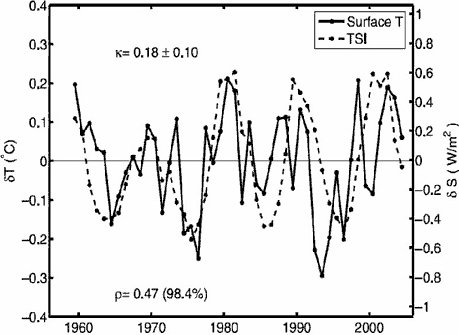Do solar cycles cause global warming?
What the science says...
Solar cycles cause global warming
A new peer-reviewed study on Surface Warming and the Solar Cycle found that times of high solar activity are on average 0.2°C warmer than times of low solar activity, and that there is a polar amplification of the warming. This result is the first to document a statistically significant globally coherent temperature response to the solar cycle, the authors note (source: Mark Morano).
The study is Surface warming by the solar cycle as revealed by the composite mean difference projection by Charles D. Camp and Ka Kit Tung. They find a global warming signal of 0.18°C attributable to the 11-year solar cycle. Eg - from solar minimum to solar maximum, global temperatures increase 0.18°C due to an increase in Total Solar Irradiance (TSI). To find the solar signal, they detrended the temperature data by removing the global warming trend. They found the detrended temperature correlated well with the solar cycle.

Figure 1: Detrended temperature (solid) compared to TSI (dotted) (Camp 2007)
However, a fair degree of climate variability contaminated the signal. Volcanic eruptions in 1982 and 1991 coincided with solar maximums. Similarly, the El Nino peak of 1998 occured during low solar activity. Tung and Camp filtered out the noise using various statistical techniques and found an even higher correlation with the solar cycle.
They concluded that from solar minimum to maximum (eg - from 1996 to 2001), the forcing from the sun increases global temperatures by 0.18°C. Conversely, from solar maximum to minimum (eg - from 2001 to 2007), the reduced forcing from the sun cools global temperatures by 0.18°C. This 11 year cycle is superimposed over the long term global warming trend.
Climate Sensitivity
Camp and Tung explore the ramifications further in a follow-up paper Solar-Cycle Warming at the Earth’s Surface and an Observational Determination of Climate Sensitivity. Independently of models, they calculate a climate sensitivity between 2.3 to 4.1°C. Eg - if CO2 levels are doubled, global temperatures will increase around 3.2°C. This confirms the IPCC estimate of climate sensitivity. In Tung's own words, "The finding adds to the evidence that mainstream climate models are right about the likely extent of future human-generated warming. It also effectively rules out some lower estimates in those models."
The other significant finding is that solar forcing will add another 0.18°C warming on top of greenhouse warming between 2007 (we're currently at solar minimum) to the solar maximum around 2012. In other words, solar forcing will double the amount of global warming over the next five to six years.
Last updated on 9 July 2010 by John Cook.































 Arguments
Arguments

































Climate Myth...